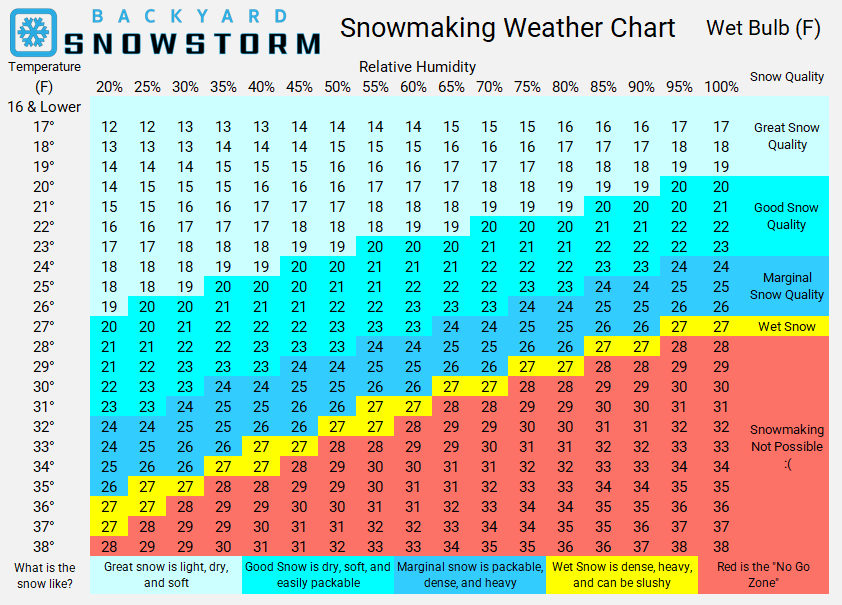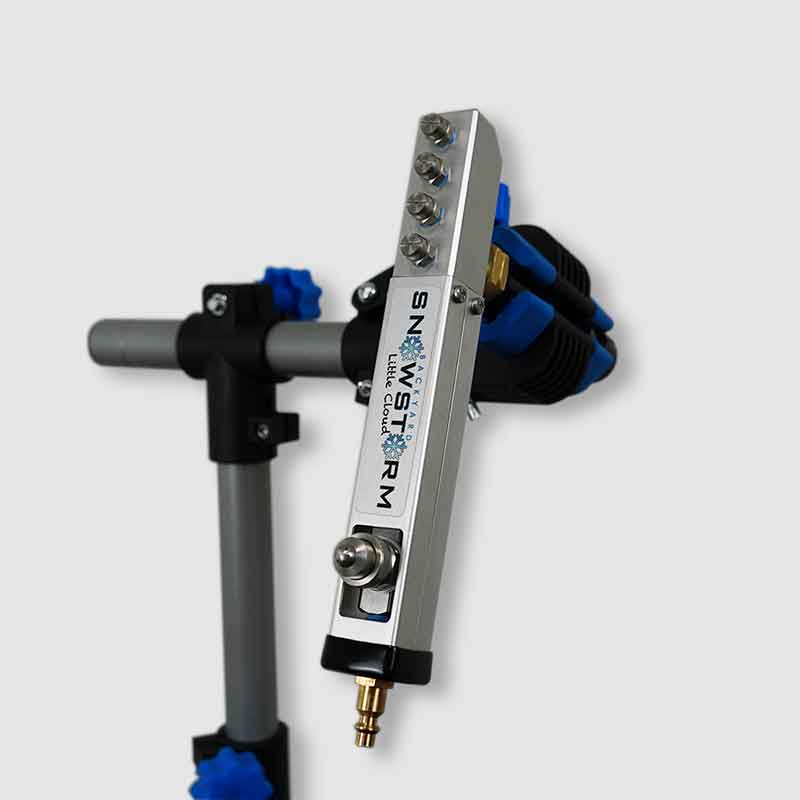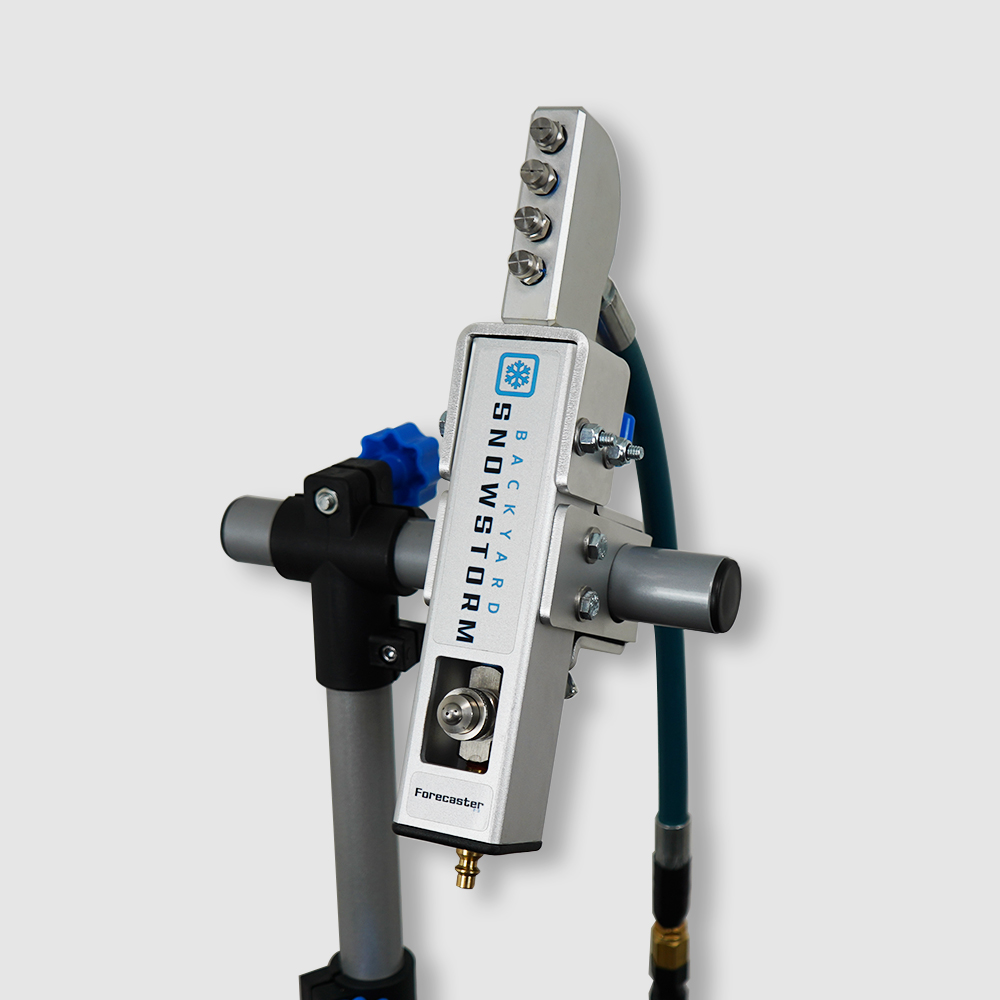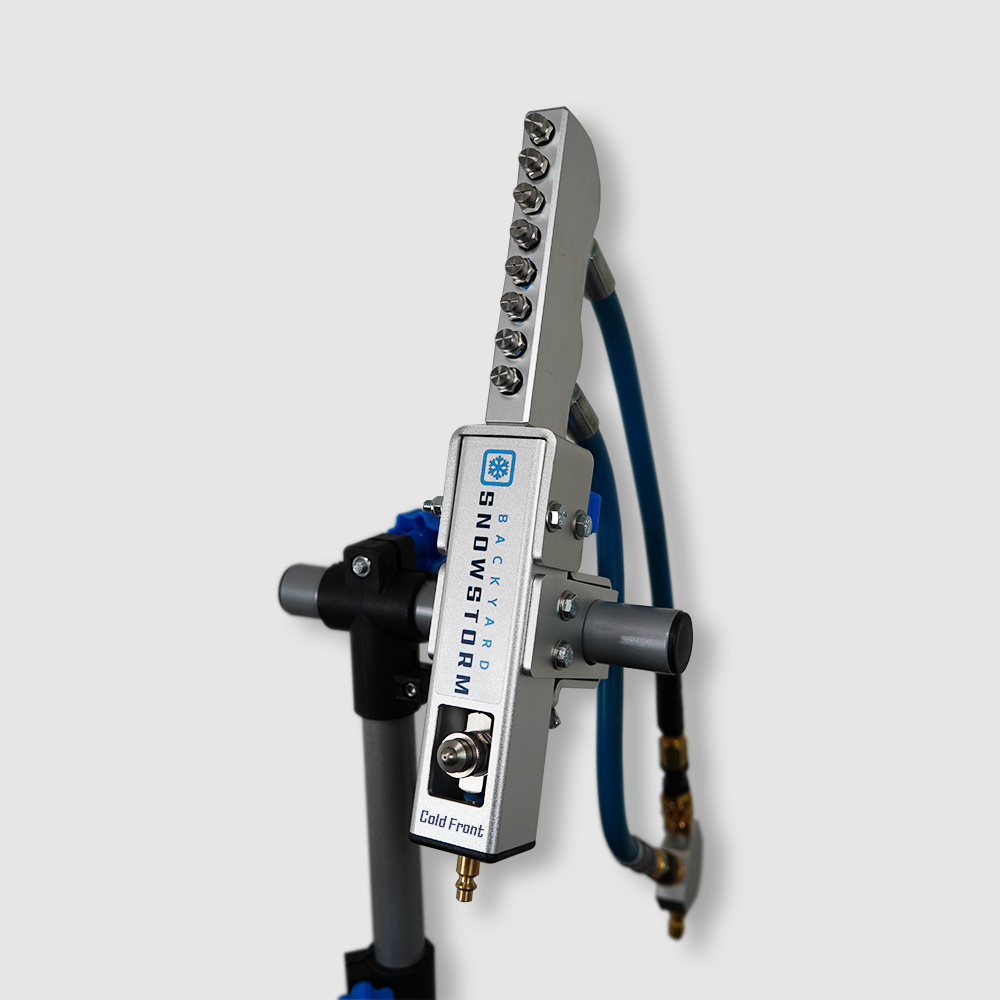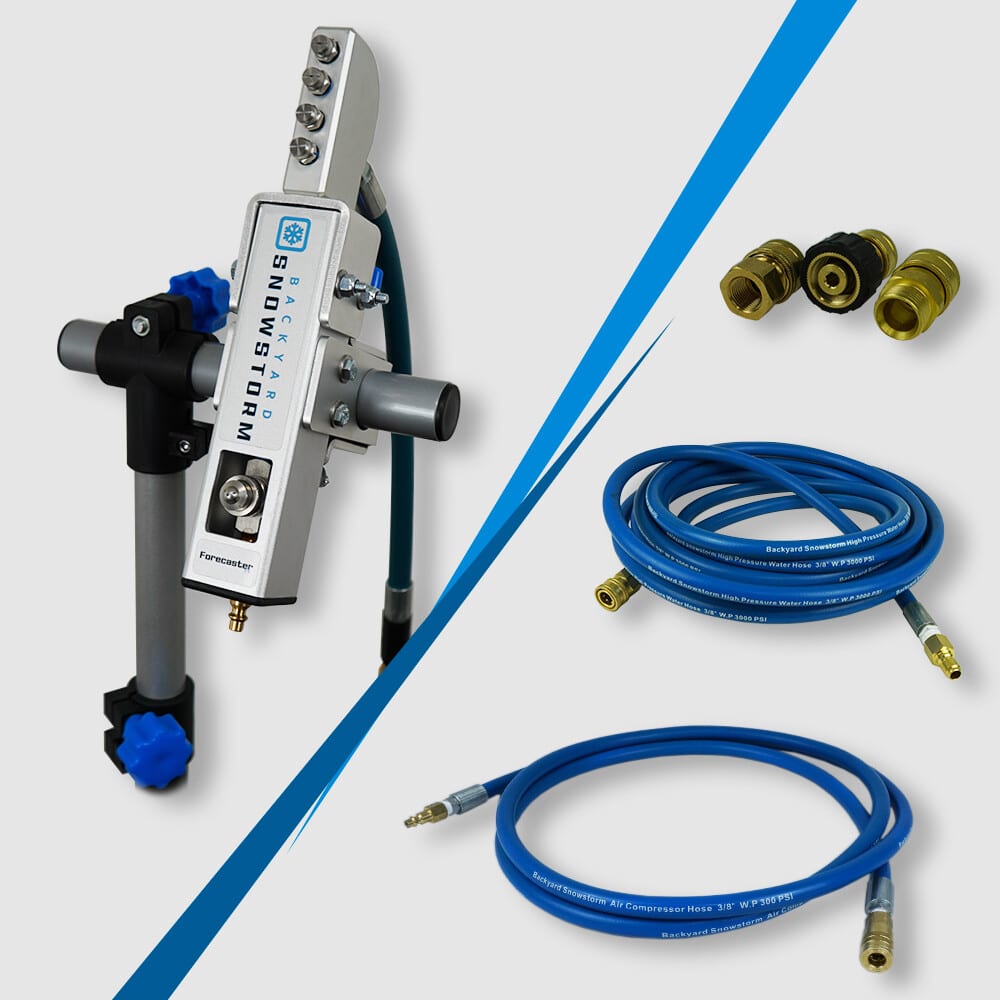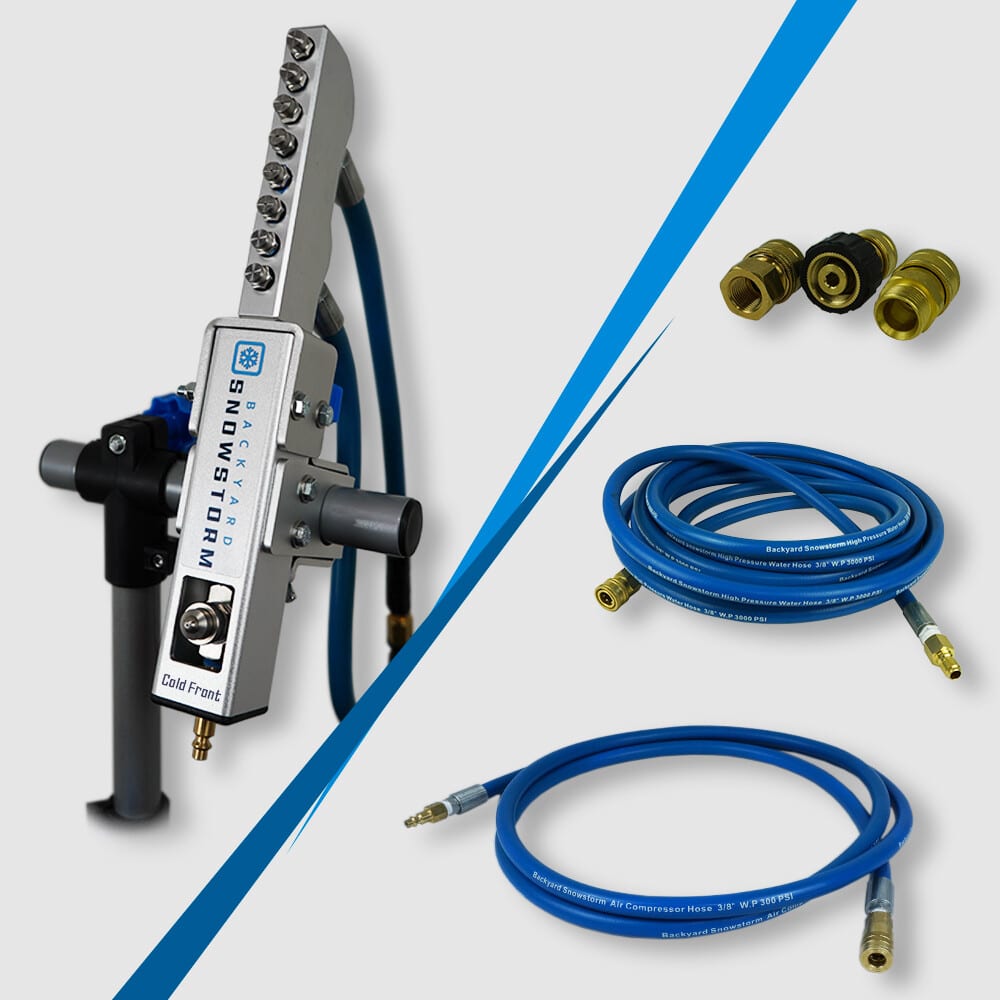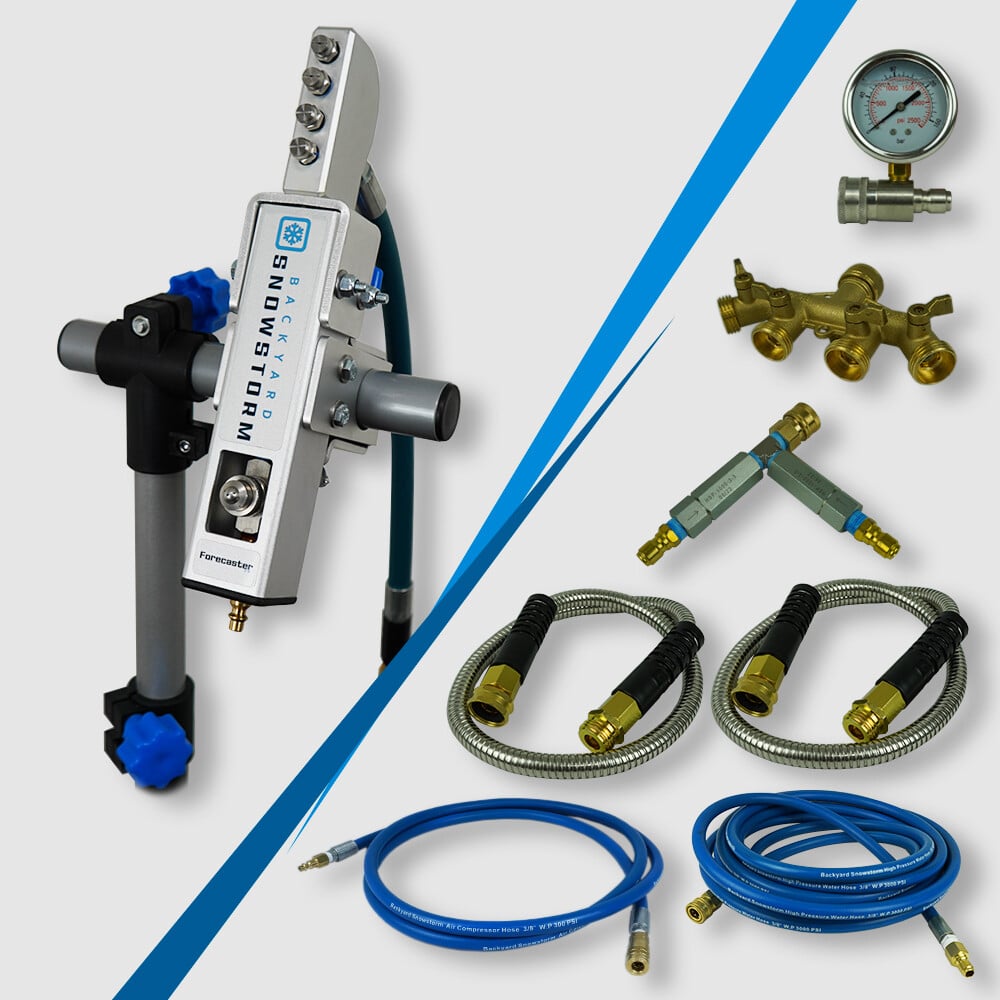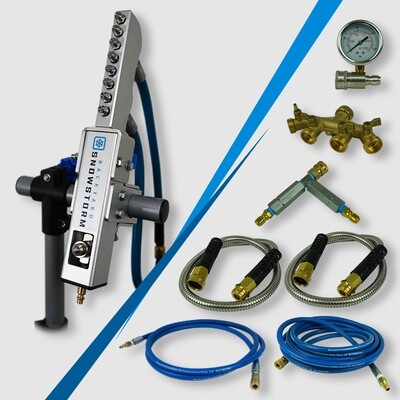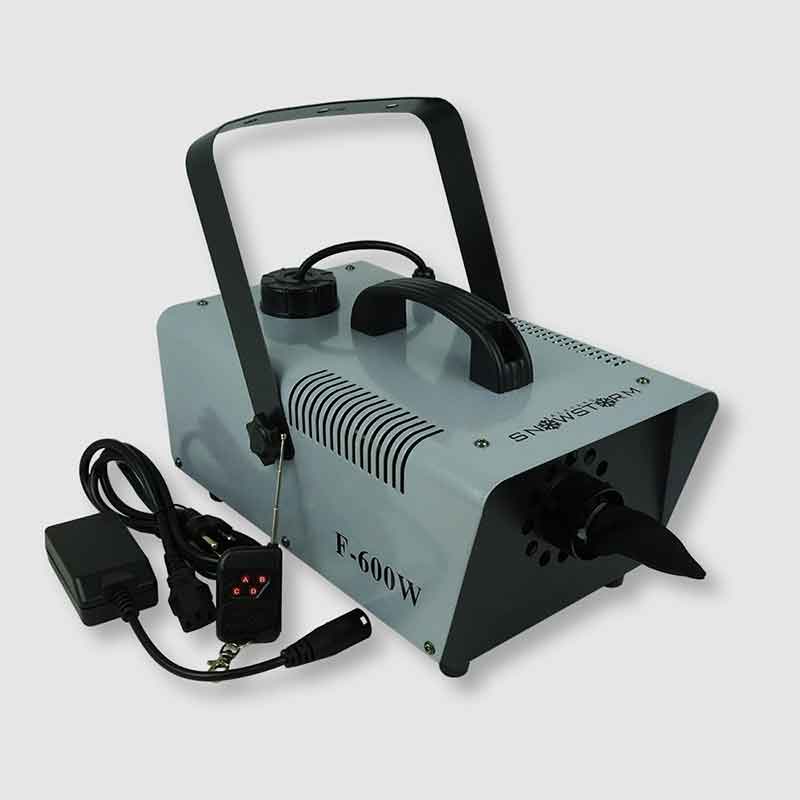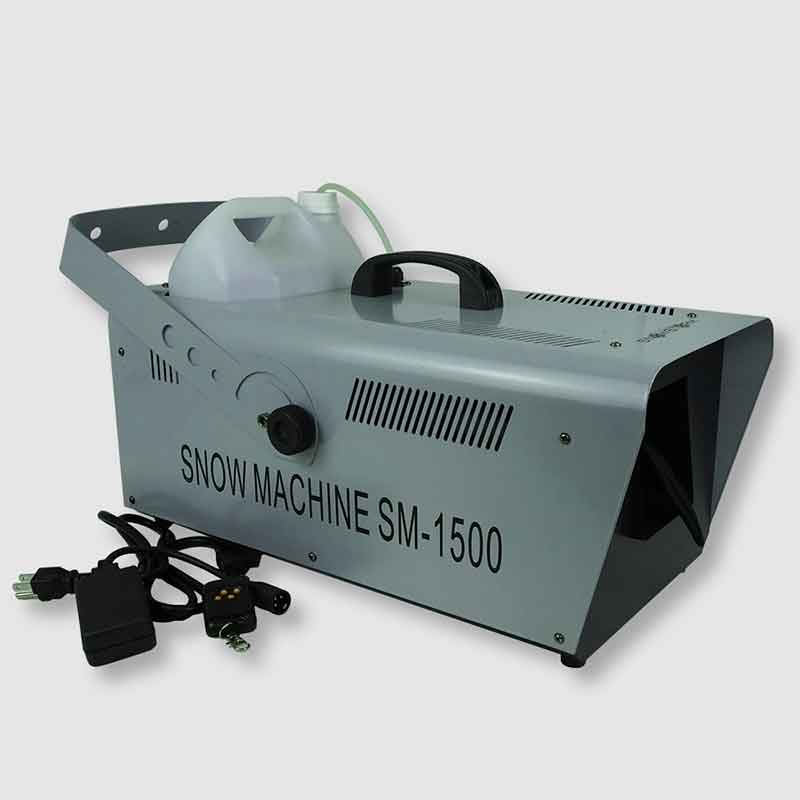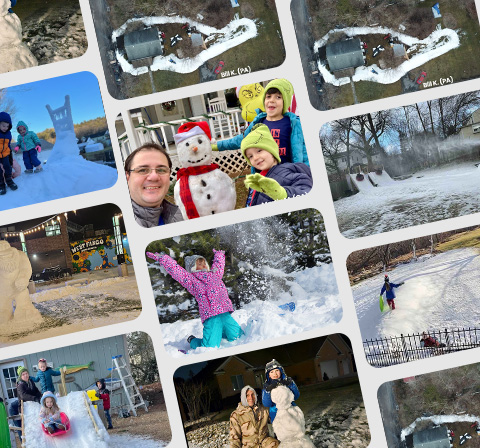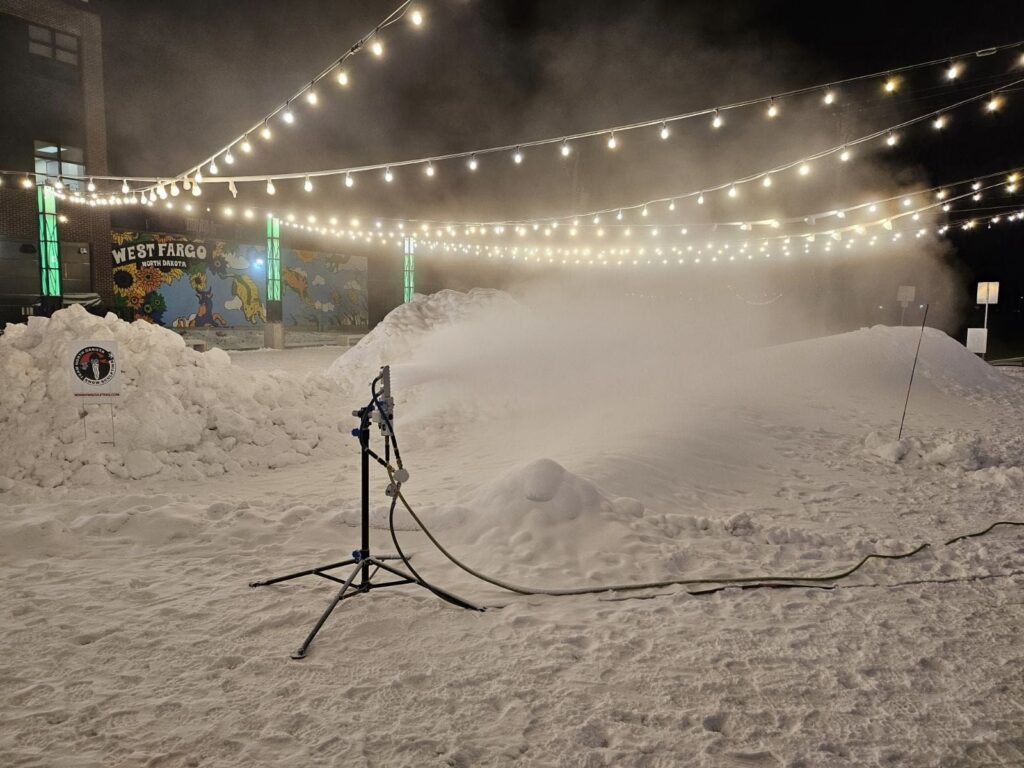-LEARN
Home Snowmaking Science and Residential Snow Gun Design Basics
The purpose of this primer on snowmaking science and snow gun design is to provide basic information that will make you a better backyard snowmaker. Armed with this basic knowledge, you will better understand how to operate the Backyard Snowstorm system and avoid common snowmaking pitfalls. You will also better understand the benefits of the Backyard Snowstorm design. References are provided at the end of this section for all you techno geeks who really want to understand the thermodynamic, physics, and chemical details of snowmaking science (which is very cool).
How a Snowflake Forms
- Proper air temperature and humidity
- water droplets
- Snow crystal nucleating site
Wet Bulb Temperature
When can I make snow? The answer depends on the wet bulb temperature which is calculated from air temperature and relative humidity. We provide a chart of wet bulb temperatures in the Snowmaking Weather Chart. A wet bulb temperature of 27 oF (-3 oC), is required to make snow. If you consult the Snowmaking Weather Chart you can see, for example, if the relative humidity is 50%, then an air temperature of 32oF (0oC) is required to make snow (at a wet bulb temperature of 27oF (-3oC).
Man-made snow quality will depend on several factors, but primarily on wet-bulb temperature. At a wet bulb temperature of 27oF (-3oC), snow quality will be very wet. As the wet bulb temperature decreases, the “dryness” of the snow will improve. A wet bulb temperature below 20oF (-7oC) is generally accepted as optimal for snowmaking quality.


Nucleator
Snowmakers are designed to mimic (and sometimes improve) on Mother Nature’s recipe for snow making. Natural snow forms in clouds around microscopic dust nucleating sites and snowflake crystals grow as these “flakes” fall over a fairly long duration (often minutes). A man-made snowmaker must replicate these conditions near the ground, with only seconds of water droplet “hang-time” in which to form snow crystals.
Since providing microscopic dust particles is impractical, a man-made snowmaker utilizes a “nucleator” to create microscopic ice crystal nucleation sites. To form ice crystal nucleation sites, water droplets must be sheared down to a size of 30 to 70 micron. A micron is .001 millimeters or 0.00004 inches. A typical rain drop is 1,000 to 5,000 micron. A human hair is about 50 micron wide.
30 to 70 micron water droplets can be made in a spray nozzle with a very small discharge opening and typically requires water pressures over 2,000 psi. Alternately, these “nucleating” size water droplets can be made by colliding air at high velocity with larger droplets of water. Most snow makers utilize a collision of air and water to form nucleating sized water droplets.
An important phenomenon to understand in air assisted nucleators is the cooling effect of expanding compressed air. For the techno nerds, this is explained by the ideal gas law, or more specifically by the Joule-Thompson effect. For the rest of us, we know from experience that when you clean your computer with a can of compressed air, the can gets cold when you depress the trigger and release the compressed air. In an air assisted nucleator, air is typically released into the nucleator at 90 to 100 psi and rapidly expands to atmospheric pressure (0 psi on a gauge). This rapid expansion creates high velocity to shear the water droplets into small sizes and simultaneously “supercools” the microscopic water droplet. A change of 100 psi in air pressure can provide 4 to 10 degrees F of cooling to the water droplet. If the air compressor is operated outdoors, then the nucleator will typically create water droplets 4 to 10 degrees cooler than the surrounding air temperature, and micro ice crystals will form nearly instantaneously.
Air assisted nucleators or “atomizing nozzles” require a fairly high air to water ratio to operate optimally. For example, the Backyard Snowstorm nucleating nozzle is designed to operate at 3 to 6 SCFM of air to 0.08 to 0.24 gpm of water. The nucleating nozzle performs optimally with air flow in the 4 to 6 SCFM air range. Starving the nucleator of sufficient air flow (by putting a small air compressor in the system, or freezing the air line) will negatively affect its effectiveness.
Misting Nozzles
Most of the water that flows into the Backyard Snowstorm snow gun exits through misting nozzles. The size and number of misting nozzles is selected based on the desired water flowrate through the system. The misting nozzles are designed to provide water droplets in the range of 500 to 1500 microns. This droplet size is optimal for growing snow crystals around the 30 to 70 micron nucleating crystals formed in the nucleator.
Since the misting nozzles are flat fan nozzles with a discharge arc of 65 degrees, it is important that sufficient nucleating ice crystals are available to the full breadth of the nozzle spray arc. The Backyard Snowstorm design is unique compared to other residential snow guns, since the nucleator is designed to discharge in a 65 degree cone to match the width of the misting nozzle spray arc. All of the water droplets discharged from the misting nozzles collide with nucleation crystals from the nucleator, significantly improving the quality of the snow.
The misting nozzles are designed to operate optimally between 700 to 1500 psi. of water pressure (thus the need for a pressure washer). The size of the nozzle discharge opening and the number of nozzles must be matched to the water flowrate in the system. For example, when a single 1.2 gpm pressure washer is used with the snow gun, we select 2 operating nozzles designed to operate at 0.6 gpm per nozzle and 1000 psi of pressure drop across each nozzle (the other two nozzle ports are filled with plug nozzles that allow for future expansion of the snow gun). When a quad train system is utilized with four 2.3 gpm pressure washers working together, the total water flowrate to the snow gun will be approximately 9.2 gpm. In this case we select 4 operating nozzles designed to operate at 2.3 gpm per nozzle and 1000 psi of pressure drop across each nozzle.
Water Filters
In the Backyard Snowstorm package system, we provide two filters. The first filter is sized at 50 mesh openings (297 micron), and is placed downstream of the supply hose and prior to the splitter that feeds the pressure washers. Household water can contain a number of insoluble contaminants. This first filter protects the pressure washers from being ruined by small solids from the supply hose.
The second filter is sized at 100 mesh openings (149 micron) and is found on the snow gun piping just downstream of the water connection. This filter protects the nozzles from becoming plugged with solid materials that may come from the water supply, or from small solids that come from the system itself (rubber, calcium carbonate scale, rust, etc.).
Do not operate the system with the filters removed. Damage and/or plugging may occur. Also, clean the filters regularly.
Air Dryer or Insulation
When air is compressed in the compressor, humidity in the air may condense and form water droplets in the compressor tank or in the air line. In snowmaking conditions, these condensing water droplets can become problematic resulting in freezing and plugging the air line, and/or freezing and plugging the nucleator. A common air drying kit can be purchased and installed on the compressor to remedy this problem. Another option is to insulate the air hose so that freezing cannot occur.
Check Valves
The Backyard Snowstorm package system includes a check valve (non-return valve) at the discharge of each pressure washer (for multi-train systems). Most pressure washers will be ruined if high pressure water is pumped backward through the system. The check valves are placed at the discharge manifold where the pressure washer discharges are combined. The check valves protect each pressure washer from water flowing backward when it is not running. DO NOT operate multiple pressure washers without the check valves installed.
A check valve is also supplied in the snow gun piping between the air connection and the nucleating nozzle. This check valve protects the air system from inadvertent contamination of water from the nucleating nozzle.
How Important is Water Supply Temperature?
It may seem logical that water supply temperature is critical to success of snowmaking. Let’s explore the basics to see.
Sensible heat is the energy required to heat or cool a liquid. Water requires sensible heat of about 1 BTU per lb. per degree F to heat or cool. For example, if you have 1 lb. of water at 50oF and you cool it to 32oF, it will require 18 BTU’s of energy removal to cool it.
Latent heat of fusion is the energy required to freeze a liquid to a solid. Water requires 144 BTU per lb. to freeze. So in our example of 1 lb. of water, 144 BTU’s of energy must be removed from the water to freeze it.
If we started with 1 lb. of water at 32 oF, the energy removal requirement to freeze is 144 BTU. If we start with 1 lb. of water at 50 oF, the energy removal requirement is 162 BTU (144 + 18). This is a 12.5% increase in heat removal requirement. That may seem significant, but let’s consider the effect of droplet size and hang time on freezing…
The hang-time required to freeze water droplets (of a given size) is essentially proportional to the energy removal requirement. So, the hang-time required to freeze 50 oF water is about 12.5% longer than water at 32 oF.
In contrast, the droplet diameter size has a significant impact on hang-time required to freeze. Freeze time is roughly proportional to water droplet diameter (Murray, et al, “Freezing of Water Drops”, Journal of Glaciology, 1972, pp. 415 – 429). In other words, a 50 micron droplet will freeze 10 times (1,000%) faster than a 500 micron droplet under the same conditions.
The conclusion is that water source temperature does have a small impact on success in snow making, but properly sized nozzles are vastly more important. With properly sized nozzles, making snow with a 50 – 60oF water source is not a problem.
Confusion Surrounding Internal and External Mixing (Nucleation Nozzle)
Commercial snow guns (found at nearly all ski and snowboard resorts) can be categorized by how compressed air and water are combined. These categories are:
- Internal Mix – Air and water are mixed together inside of piping and the mixture exists the snow gun nozzles.
- External Mix – Water is sprayed through exit nozzles, and air is sprayed into the water stream outside of any piping. The main purpose of the air is to break the water droplets into smaller sizes. These external mix systems are not sufficient for self-nucleation, and usually require an internal mix air/water nucleator that is typically mounted below the main water and air discharge nozzles.
- Fan Guns – Water is sprayed through nozzles arranged in a ring at the outlet of a large fan. The fan is used to propel the water droplets from the gun. One or more internal mix air/water nucleators are typically mounted in the center of the fan discharge to provide nucleation site for the fan driven water droplets.
It is important to note that nearly all commercial snow guns use an internal mixing system for nucleation because of its superior mixing capability of air and water and consistency of nucleation droplet size creation.
The Backyard Snowstorm Snow Gun uses high pressure to breakdown the main water stream into desired water droplet sizes and propel them away from the gun and it uses an internal mix nucleator nozzle to provide nucleation sites. Our Snow Gun is not an Internal Mix Snow Gun, we use an Internal Mix nucleator.


